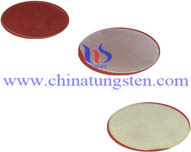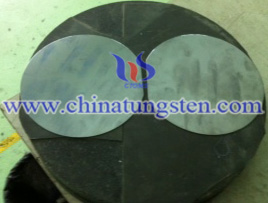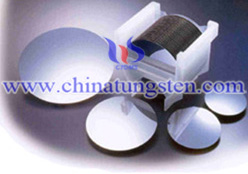High Performance Thin-Film Flip-Chip InGaN–GaN Light-Emitting Diodes
- Details
- Category: Tungsten & Sapphire Growth Furnace News
- Published on Saturday, 08 February 2014 11:48
- Hits: 2288
Data are presented on the operation of thin-film flip-chip InGaN/GaN multiple-quantum-well light-emitting  diodes (LEDs). The combination of thin-film LED concept with flip-chip technology is shown to provide surface brightness and flux output advantages over conventional flip-chip and vertical-injection thin-film LEDs. Performance characteristics of blue, white, and green thin-film flip-chip 1×1 mm2 LEDs are described. Blue (∼441 nm) thin-film flip-chip LEDs are demonstrated with radiance of 191 mW/mm2 sr at 1 A drive, more than two times brighter than conventional flip-chip LEDs. An encapsulated thin-film flip-chip blue LED lamp is shown to have external quantum efficiency of 38% at forward current of 350 mA. A white lamp based on a YAG:Ce phosphor coated device exhibits luminous efficacy of 60 lm/W at 350 mA with peak efficiency of 96 lm/W at 20 mA and luminance of 38 Mcd/m2 at 1 A drive current. Green (∼517 nm) devices exhibit luminance of 37 Mcd/m2 at 1 A.
diodes (LEDs). The combination of thin-film LED concept with flip-chip technology is shown to provide surface brightness and flux output advantages over conventional flip-chip and vertical-injection thin-film LEDs. Performance characteristics of blue, white, and green thin-film flip-chip 1×1 mm2 LEDs are described. Blue (∼441 nm) thin-film flip-chip LEDs are demonstrated with radiance of 191 mW/mm2 sr at 1 A drive, more than two times brighter than conventional flip-chip LEDs. An encapsulated thin-film flip-chip blue LED lamp is shown to have external quantum efficiency of 38% at forward current of 350 mA. A white lamp based on a YAG:Ce phosphor coated device exhibits luminous efficacy of 60 lm/W at 350 mA with peak efficiency of 96 lm/W at 20 mA and luminance of 38 Mcd/m2 at 1 A drive current. Green (∼517 nm) devices exhibit luminance of 37 Mcd/m2 at 1 A.
We have measured polarized Raman spectra in a 2.0 mu m GaN epitaxial layer of high quality, grown on a sapphire substrate. All symmetry-allowed optical phonons in GaN have been assigned as follows: A1(LO), 735 cm-1; A1(TO), 533 cm-1; E1(LO), 743 cm-1; E1(TO), 561 cm-1; E2, 144 and 569 cm-1. Using the Lyddane-Sachs-Teller relation, the static dielectric constants of GaN for the ordinary and extraordinary directions have been estimated as epsilon perpendicular to 0=9.28 and E/sub //0/=10.1. We have also observed quasi-LO phonons in GaN. A brief discussion on these will be given.
Tungsten Manufacturer & Supplier: Chinatungsten Online - http://www.chinatungsten.com
Tel.: 86 592 5129696; Fax: 86 592 5129797
Email: sales@chinatungsten.com
Tungsten & Molybdenum Information Bank: http://i.chinatungsten.com
Tungsten News & Tungsten Prices, 3G Version: http://3g.chinatungsten.com
Molybdenum News & Molybdenum Price: http://news.molybdenum.com.cn
Self-Separation of A Thick AlN Layer From A Sapphire Substrate Via Interfacial Voids Formed by The Decomposition of Sapphire
- Details
- Category: Tungsten & Sapphire Growth Furnace News
- Published on Wednesday, 29 January 2014 16:14
- Hits: 2147
A technique for separating a thick AlN layer grown by hydride vapor phase epitaxy (HVPE) on a sapphire  substrate was developed. By heat treatment at 1450 ℃ in a gas flow containing H2 and NH3, many voids could be formed at the interface between a thin (100 nm) AlN layer grown at 1065 ℃ and the sapphire substrate due to the preferential decomposition of sapphire. During the cooling process after the subsequent growth of a thick (85 μm) AlN layer, the thick AlN layer separated from the sapphire substrate with the aid of the interfacial voids. The freestanding AlN substrate thus obtained had a smooth surface, a dislocation density of 1.1× 109 cm-2, and an optical transparency for wavelengths above 208.1 nm.
substrate was developed. By heat treatment at 1450 ℃ in a gas flow containing H2 and NH3, many voids could be formed at the interface between a thin (100 nm) AlN layer grown at 1065 ℃ and the sapphire substrate due to the preferential decomposition of sapphire. During the cooling process after the subsequent growth of a thick (85 μm) AlN layer, the thick AlN layer separated from the sapphire substrate with the aid of the interfacial voids. The freestanding AlN substrate thus obtained had a smooth surface, a dislocation density of 1.1× 109 cm-2, and an optical transparency for wavelengths above 208.1 nm.
Single‐crystal layers of AlN have been grown on sapphire substrates between 1000 and 1100 °C by vapor‐phase reaction of aluminum chlorides with ammonia. The purity, color, crystallinity, growth morphology, and electrical resistivity of the epitaxial layers have been investigated. Infrared specular reflection measurements showed the presence of an appreciable strain at the AlN‐sapphire epitaxy interface. Optical absorption data strongly suggest the AlN is a direct band‐gap material with a value of about 6.2 eV at room temperature.
Tungsten Manufacturer & Supplier: Chinatungsten Online - http://www.chinatungsten.com
Tel.: 86 592 5129696; Fax: 86 592 5129797
Email: sales@chinatungsten.com
Tungsten & Molybdenum Information Bank: http://i.chinatungsten.com
Tungsten News & Tungsten Prices, 3G Version: http://3g.chinatungsten.com
Molybdenum News & Molybdenum Price: http://news.molybdenum.com.cn
Carrier Concentration and Mobility in GaN Epilayers on Sapphire Substrate Studied by Infrared Reflection Spectroscopy
- Details
- Category: Tungsten & Sapphire Growth Furnace News
- Published on Tuesday, 28 January 2014 11:55
- Hits: 2365
We report the measurement of carrier concentration and mobility of metalorganic chemical vapor deposited  GaN thin films on the sapphire substrate by an infrared reflection technique. By fitting with the experimental data we obtain all the parameters of the lattice vibration oscillators and of the plasmon. From the plasmon frequency and the damping constant we have derived the carrier concentration and the electron mobility. The concentration agrees with the Hall data very well while the mobility values are smaller than that of the Hall measurement by a factor of about 0.5. We attribute such mobility lowering to the increase of scattering for the electrons coupling with the incident photons.
GaN thin films on the sapphire substrate by an infrared reflection technique. By fitting with the experimental data we obtain all the parameters of the lattice vibration oscillators and of the plasmon. From the plasmon frequency and the damping constant we have derived the carrier concentration and the electron mobility. The concentration agrees with the Hall data very well while the mobility values are smaller than that of the Hall measurement by a factor of about 0.5. We attribute such mobility lowering to the increase of scattering for the electrons coupling with the incident photons.
GaN layers are grown on sapphire substrate by electron cyclotron resonance molecular beam epitaxy (ECR-MBE) using an ECR plasma cell with ion removal magnets on the cell top for the nitrogen source. The efficiency of the ion removal magnets in this ECR plasma cell is 99%. High-quality GaN layers are obtained. In particular, (2×2) and (4×4) RHEED (reflection high-energy electron diffraction) patterns are observed during GaN growth and during cooling after growth, respectively, indicating a flat and smooth surface of GaN. These results show the superiority of the ion-removed ECR plasma cell.
Tungsten Manufacturer & Supplier: Chinatungsten Online - http://www.chinatungsten.com
Tel.: 86 592 5129696; Fax: 86 592 5129797
Email: sales@chinatungsten.com
Tungsten & Molybdenum Information Bank: http://i.chinatungsten.com
Tungsten News & Tungsten Prices, 3G Version: http://3g.chinatungsten.com
Molybdenum News & Molybdenum Price: http://news.molybdenum.com.cn
Enhancing The Output Power of GaN-Based LEDs Grown on Wet-Etched Patterned Sapphire Substrates
- Details
- Category: Tungsten & Sapphire Growth Furnace News
- Published on Wednesday, 29 January 2014 16:03
- Hits: 2261
GaN-based light-emitting diodes (LEDs) with emitting wavelength of 450 nm were grown on patterned sapphire  substrates (PSSs) fabricated by chemical wet etching. The crystallography-etched facet was R-plane with a 57deg against C-axis and had superior capability for enhancing light extraction efficiency. The light output power of the PSS LED was 1.15 times higher than that of the conventional LED at an injection current of 20 mA. The output power and external quantum efficiency were estimated to be 9 mW and 16.4%, respectively. The improvement was attributed not only to geometrical shapes of {1-102} crystallography-etched facets that efficiently scatter the guided light to find escape cones, but also to dislocation density reduction by adopting the PSS growth scheme.
substrates (PSSs) fabricated by chemical wet etching. The crystallography-etched facet was R-plane with a 57deg against C-axis and had superior capability for enhancing light extraction efficiency. The light output power of the PSS LED was 1.15 times higher than that of the conventional LED at an injection current of 20 mA. The output power and external quantum efficiency were estimated to be 9 mW and 16.4%, respectively. The improvement was attributed not only to geometrical shapes of {1-102} crystallography-etched facets that efficiently scatter the guided light to find escape cones, but also to dislocation density reduction by adopting the PSS growth scheme.
Lattice constants of gallium nitride (wurzite structure) have been measured at temperatures 294–753 K. The measurements were performed by using x‐ray diffractometry. Two kinds of samples were used: (1) bulk monocrystal grown at pressure of 15 kbar, (2) epitaxial layer grown on a sapphire substrate. The latter had a smaller lattice constant in a direction parallel to the interface plane by about 0.03%. This difference was induced by a higher thermal expansion of the sapphire with respect to the GaN layer. However, this thermal strain was created mainly at temperatures below 500–600 K. Above these temperatures the lattice mismatch in parallel direction diminished to zero at a temperature of about 800 K.
Tungsten Manufacturer & Supplier: Chinatungsten Online - http://www.chinatungsten.com
Tel.: 86 592 5129696; Fax: 86 592 5129797
Email: sales@chinatungsten.com
Tungsten & Molybdenum Information Bank: http://i.chinatungsten.com
Tungsten News & Tungsten Prices, 3G Version: http://3g.chinatungsten.com
Molybdenum News & Molybdenum Price: http://news.molybdenum.com.cn
In Situ Ttemperature Measurements Via Ruby R Lines of Sapphire Substrate Based InGaN Light Emitting Diodes During Operation
- Details
- Category: Tungsten & Sapphire Growth Furnace News
- Published on Tuesday, 28 January 2014 11:40
- Hits: 2360
The temperature of encapsulated green and ultraviolet light emitting diodes (LEDs) in operation has been  measured optically via the ruby R lines emitted by the residual Cr3+ contaminations in the sapphire substrate. These two photoluminescent R lines, which are excited by the electroluminescence of the LED itself, show a well-characterized line shift as a function of temperature and pressure. The temperature is found to rise linearly with the applied forward current of the LED at a rate of ≈1 K/mA. This optical temperature measurement based on monitoring the two ruby R lines could qualify as a sensitive method for an in situ temperature sensor for other sapphire substrate based semiconductor devices such as laser diodes and field effect transistors.
measured optically via the ruby R lines emitted by the residual Cr3+ contaminations in the sapphire substrate. These two photoluminescent R lines, which are excited by the electroluminescence of the LED itself, show a well-characterized line shift as a function of temperature and pressure. The temperature is found to rise linearly with the applied forward current of the LED at a rate of ≈1 K/mA. This optical temperature measurement based on monitoring the two ruby R lines could qualify as a sensitive method for an in situ temperature sensor for other sapphire substrate based semiconductor devices such as laser diodes and field effect transistors.
Indium–gallium nitride (InxGa1-xN) single-quantum-well (SQW) light emitting diodes (LEDs), grown by metalorganic chemical vapor deposition on sapphire, were transferred onto Si substrates. The thin-film InxGa1-xN SQW LED structures were first bonded onto a n+-Si substrate using a transient-liquid-phase Pd–In wafer-bonding process followed by a laser lift-off technique to remove the sapphire growth substrate. Individual, 250×250 μm2, LEDs with a backside contact through the n+-Si substrate were then fabricated. The LEDs had a typical turn-on voltage of 2.5 V and a forward current of 100 mA at 5.4 V. The room-temperature emission peak for the InxGa1-xN SQW LEDs was centered at 455 nm with a full width at half maximum of 19 nm.
Tungsten Manufacturer & Supplier: Chinatungsten Online - http://www.chinatungsten.com
Tel.: 86 592 5129696; Fax: 86 592 5129797
Email: sales@chinatungsten.com
Tungsten & Molybdenum Information Bank: http://i.chinatungsten.com
Tungsten News & Tungsten Prices, 3G Version: http://3g.chinatungsten.com
Molybdenum News & Molybdenum Price: http://news.molybdenum.com.cn
More Articles...
- High Quality Epitaxial Aluminum Nitride Layers on Sapphire by Pulsed Laser Deposition
- Ultraviolet Electroluminescence from N-ZnO:Ga/p-ZnO:N Homojunction Device on Sapphire Substrate with P-Type ZnO:N Layer Formed by Annealing in N2O Plasma Ambient
- Direct Growth of A-Plane GaN on R-Plane Sapphire Substrate by Metalorganic Vapor Phase Epitaxy
- The Role of Inner And Internal Radiation on The Melt Growth of Sapphire Crystal





 sales@chinatungsten.com
sales@chinatungsten.com